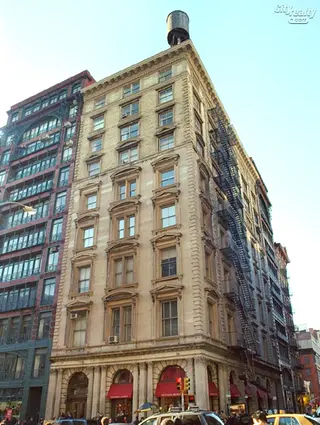 Carter Horsley
Carter HorsleyFeb 25, 2013
Carter's Review
This 9-story building at 565 Broadway on the southwest corner at Prince Street is one of the most elegant in SoHo.
It has 10 co-operative apartments and ground-floor retail.
The original, East Chester marble-clad building was erected in 1860 as a five-story structure designed by John Kellum for John A. May, an umbrella manufacturer. In 1883, four floors were added with cream-colored brick façades but proportions and quoins that related closely to the original building and were capped with a handsome cornice with a large eagle with spread wings atop the center of the Broadway cornice.
It was originally constructed for Ball, Black & Company, a luxury goods concern that was moving north from 247 Broadway and was a rival of Tiffany & Co., then at 550 Broadway.
Bottom Line
Its prime location at the most impressive intersection in SoHo makes it very convenient to the neighborhood’s many boutiques and restaurants. It is across from a Prada store, next to a subway station and a few steps from the Mercer Hotel.
Description
The building, which is also known as 82-86 Prince Street, is topped by a tall watertank at the corner and has fire-escapes on its Prince Street façade. It is also surrounded on Prince Street and Broadway by the wings of Ernst Flagg’s Little Singer Building, one of the great landmarks of the SoHo Historic District.
The building has fluted circular and square Corinthian columns on its first floor and permits protruding air-conditioners.
Amenities
Most of the apartments are full-floors of about 5,000 square feet and they have high ceilings and an elevator.
Apartments
Apartment 6W is a one-bedroom unit has a 43-foot-long living area with a open kitchen, a 10-foot wide office and 14-foot-long bedroom and a 22-foot-long secondary living area.
A unit that fronts on Prince Street has a 37-foot-long living area with a 20-foot-wide sleeping area and a 16-foot-long dining area with an open kitchen.
History
According to Tom Miller of daytoninmanhattan.blogspot.com, Ball, Black was founded in 1810 and originally was located at 166 Broadway and was considered “the jewelry store of New York City.”
“Touted as the first ‘absolutely fire-proof’ building in New York, the vaults below street level contained the first safe deposit system in the United States. The single-sheet panes of plate glass imported for the first floor windows – 14 feet, 8 inches tall and 9 feet, 2 inches wide - were thought to be the largest ever made,” the blogspot continued, adding that the company went out of business in 1874.
In 1890, the building was taken over by Banner Brothers, a men’s apparel concern, but Charles and Moritz Freedman bought the building in 1893 and they hired Little & O’Connor to design a four-story rooftop addition.
In 1904, the street-level retail space was taken over the Mechanics’ & Traders’ Bank, which would merge with the chase National Bank in 1921 and by 1912 a building tenant was selling collar stays and several tenants made straw hats for women.
In 1979, Martin R. Fine commissioned Joseph Pell Lombardi to convert the building to residential co-operative apartments and in 1992 a cornice that had been previously removed was reproduced. Mr. Fine had donated a façade easement in 1879 to the New York Landmarks Conservancy that enable him to get a tax deduction for agreeing to restore the missing cornice within 18 months. According to the October 18, 1992 “Streetscapes” column by Christopher Gray in The New York Times, he never did and “the co-op corporation also was reluctant to restore the cornice,.” It was put back, however, in 1992 “to increase the sale value of apartments,” according to Mr. Gray.
An anonymous reader of the blogspot posted a comment January 27, 2913 that the prince of Wales visited the store in 1869 according to the website of Black, Star and Frost, the extension of Ball, black and Company I the present day,.”

- Co-op built in 1860
- Converted in 1979
- 2 apartments currently for sale ($2.5M to $5.75M)
- Located in SoHo
- 10 total apartments 10 total apartments
- 10 recent sales ($1.5M to $5.2M)
- Pets Allowed
 6sqft delivers the latest on real estate, architecture, and design, straight from New York City.
6sqft delivers the latest on real estate, architecture, and design, straight from New York City.
